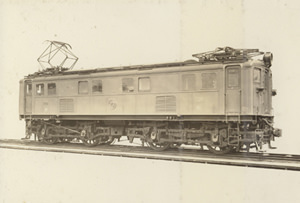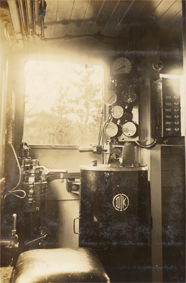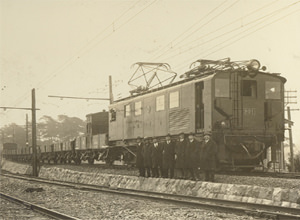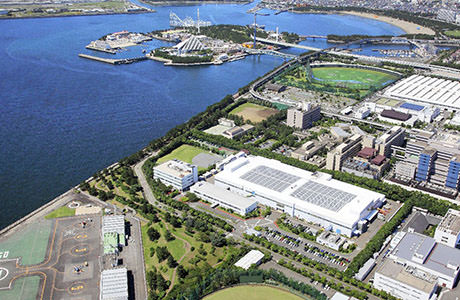
- HOME
- News
- Corporate Information
- Investor Relations
- Products Information
- Transportation Systems
- Transportation Systems Products
- Propulsion inverters
- Auxiliary Power Supply
- Traction motors
- Driving gear units
- Pantograph
- The total train communication system
- The passenger information display system
- Twin disk couplings
- Door operating equipment
- High speed circuit breakers・Unit Switch
- Railway Power Storage System
- E3 Solution System
- Industrial Systems
- Testing System for Automobiles
- Testing System for Automobiles
- Dynamo (dynamometer)
- Mechanical Systems
- Control and Measurement Operations
- Battery Simulator
- Power Generation and Social Infrastructure System
- Emergency Generators
- Continuous-Use Generators
- Generating Equipment for Distributed Power Source
- Water Supply and Sewage Equipment Systems
- Production and Processing Equipment Systems
- Toyo Network System
- Printing
- Tire and Rubber
- Films and Plastics
- Paper Manufacturing
- Metal Processing
- Automotive Electrical Equipment
- Lineup
- Information Equipment Systems
- Station Operating equipment Systems
- Commuter pass vending machine / Composite ticket vending machine
- Mobile device for the conductor
- Compact vending machine
- Decision Engines
- Remote Monitoring Systems
- M2M Solution
- Vehicle Monitoring Solution
- Equipment Management
- Facilities Management
- Sensor Monitoring
- Custom Solution
- Solution Examples
- IORemoter Terminal for
Remote Monitoring and Control System - Electricity Visualization Solution
- Wireless Current Sensor μTURTLE-I
- Wireless Electricity Sensor μTURTLE-P
- Wireless Analog Sensor μTURTLE-A
- Wireless Pulse Sensor μTURTLE-PL
- Receiving Unit
μTURTLE-R、RL、RW
- ESG / CSR
- Contact Us
- HOME
- Corporate Information
- Establishment of the Company
Corporate Information
Establishment of the Company

Railway History in Japan
A railway station was opened for the first time in 1872 in Japan. Running of the U.K make steam locomotive between Tokyo (Shimbashi ) and Yokohama (Sakuragicho Station) astonished people, and make the event epochal in history.
In 1895, Kyoto Electric Railway operated tramcars between Kyoto-Station and Fushimi for the first time, which was the start of the modernization of urban transportation in Japan. Since then, the railway technology in our country made a remarkable progress and the domestic manufacturing of train bodies and rails rapidly advanced. But for main electric equipment including traction motors, and control equipments as a heart of the train, we had to depend on import.

Hanwa Electric Railway Loco 1001 (approximately 1930)
Internationalization of Japanese Railway Industry
Under such circumstances, World War I began in 1914. During the munitions boom, the electric railway tended to grow and flourish, but the import of important the electric equipments stopped. Then, the tendency to manufacture the electric equipments for vehicles on our own instead of depending on the imported products started and grew in the railway industry, as well as other industries in Japan.
Establishment of Toyo Denki
In 1917, Mr. Kaichi Watanabe (the first president of our company) long known as a pioneer of the electric railway industry in Japan, president of then Ishikawajima Ship Building Co, (now called as IHI), and a director of Keihan Electric Railway Co, made technical cooperation with a British company, Dick Kerr & Co., Ltd. (later changed to English Electric Co.), world-famous as an electric machine manufacturer, and subsequently on June 20, 1918, he planned the domestic production of the company's products and established Toyo Denki Seizo K.K. with the capital of 3 million yen.
In the following year, our company constructed its Yokohama Factory in a good location (Nishikubo-machi Hodogaya-ku of Yokohama City), west of the Yokohama Port, then the best prosperous trading port in our Japan. Simultaneously with the factory construction, our company started manufacturing activities, and in 1920, it completed its first control equipments and traction motors and delivered them to Keihan Electric Railway Co. They were well received and it was a good opportunity to start the delivery of the products to main electric railway companies across Japan, thus establishing the position of our company as a specialist manufacturer.

Odawara Express Electric Railway Deki 201 Cabin

Odawara Express Electric Railway Deki 201
Naming of the Company
The development of Japan's domestic railway industry was rapidly accelerated by historical developments in the early 19th century, when the outbreak of World War I in 1914 led to interruptions in the supply of electrical equipment from Europe to Japan.
The charter originally establishing Toyo Denki as a company stated that development of Japan's domestic railway industry would help to meet Japanese demand for railway equipment in the face of interruptions in supply from other countries due to the outbreak of World War I, and that a domestic railway industry would create an alternative to imports and prevent the outflow of capital from Japan. The charter also outlined the company's mission of exporting Japanese railway equipment to other countries in the Orient, which would bring in foreign currency and contribute to Japan.
It was decided to name the firm Toyo Denki Seizo (literally "Oriental Electric Manufacturing") to reflect the sweeping vision of developing Japan's domestic railway industry and exporting products to the rest of the Orient, for the benefit of Japan's industrial development.

Yokohama Works Today
- Corporate Information
- Business Principles
Message from Top Management - Company Profile
- Long-Term Vision
Medium-Term Management Plan - Corporate Governance
- List of Directors, Auditors and Operating Officers
- Directory
- Affiliates
- Establishment of the Company
- History
- News Release
- Quality and Environmental management
- Personal Information Protection Policy
- Business Principles
PAGE TOP